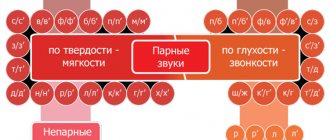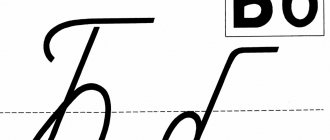§10. Letters and sounds
Letters and sounds have different purposes and different natures. But these are comparable systems. Therefore, you need to know the types of ratios.
Types of relationships between letters and sounds:
- The letter denotes a sound, for example vowels after hard consonants and consonants before vowels: weather.
- The letter does not have its own sound meaning, for example ь and ъ: mouse
- The letter denotes two sounds, for example, iotated vowels e, e, yu, i in the positions:
- the beginning of a word
- after vowels,
- after the separators ь and ъ.
- A letter can denote a sound and the quality of a preceding sound, such as iotated vowels and and after soft consonants.
- A letter can denote the quality of the preceding sound, for example ь in the words shadow, stump, firing.
- Two letters can mean one sound, often a long one: sew, compress, rush
- Three letters correspond to one sound: smile - ts - [ts:]
Final test
What determines the quality of a vowel sound?
- From the shape of the oral cavity at the moment of pronouncing the sound
- From the barrier formed by the speech organs at the moment of pronouncing a sound
What is reduction called?
- pronouncing vowels under stress
- pronouncing unstressed vowels
- special pronunciation of consonants
For which sounds does the air stream encounter an obstacle on its path: a bow or a gap?
- In vowels
- In consonants
Can voiceless consonants be pronounced loudly?
- Yes
- No
Are the vocal cords involved in pronouncing voiceless consonants?
- Yes
- No
How many pairs of consonants are formed according to deafness and voicedness?
- 5
- 11
- 20
How many consonants do not have a voiced-voiced pair?
- 5
- 10
- 14
How many pairs do Russian consonants form according to hardness and softness?
- 10
- 15
- 20
How many consonants do not have a hard-soft pair?
- 3
- 6
- 12
How is the softness of consonants conveyed in writing?
- Special icons
- Letter combinations
What is the name of the position of a sound in a stream of speech in which it appears in its basic form, without undergoing positional changes?
- Strong position
- Weak position
What sounds have strong and weak positions?
- In vowels
- In consonants
- For everyone: both vowels and consonants
Right answers:
- From the shape of the oral cavity at the moment of pronouncing the sound
- pronouncing unstressed vowels
- In consonants
- No
- No
- 11
- 14
- 15
- 6
- Letter combinations
- Strong position
- For everyone: both vowels and consonants
§4. Method of formation of consonants
Consonants are sounds, when pronounced, the air encounters an obstacle in its path. There are two types of obstruents in the Russian language: gap and stop - these are the two main ways of forming consonants. The type of obstruction determines the nature of the consonant sound.
A gap is formed, for example, when pronouncing sounds: [s], [z], [sh], [z]. The tip of the tongue only approaches the lower or upper teeth. Frictional consonants can be drawn out: [s-s-s-s], [sh-sh-sh-sh]. As a result, you will clearly hear the noise: when pronouncing [c], it is whistling, and when pronouncing [sh], it is hissing.
The stop, the second type of articulation of consonants, is formed when the speech organs close. The air flow abruptly overcomes this obstacle, the sounds are short and energetic. That's why they are called explosive. You won't be able to pull them. Such, for example, are the sounds [p], [b], [t], [d]. Such articulation is easier to feel and sense.
So, when pronouncing consonants, noise is heard. The presence of noise is a distinctive feature of consonants.
§8. Place of formation of consonants
Consonants differ not only according to the characteristics already known to you:
- deafness-voice,
- hardness-softness,
- method of formation: bow-slit.
The last, fourth sign is important: place of formation . The articulation of some sounds is carried out by the lips, others - by the tongue, its different parts. So, the sounds [p], [p'], [b], [b'], [m], [m'] are labial, [v], [v'], [f], [f' ] – labial-dental, all others – lingual: anterior lingual [t], [t'], [d], [d'], [n], [n'], [s], [s'], [z ], [z'], [w], [zh], [w':], [h'], [ts], [l], [l'], [r], [r'], middle language [ th'] and back-lingual [k], [k'], [g], [g'], [x], [x'].
§1. Sound
Sound is the minimum unit of sounding speech. Each word has a sound shell consisting of sounds. The sound corresponds to the meaning of the word. Different words and word forms have different sound patterns. The sounds themselves are not important, but they serve an important role: they help us distinguish between:
- words: [house] - [tom], [tom] - [there], [m'el] - [m'el']
- forms of the word: [house] – [lady´] – [house´ma].
Note:
words written in square brackets are given in transcription.
§9. Positional changes of sounds
Strong-weak positions for vowels. Positional changes of vowels. Reduction
People do not use spoken sounds in isolation. They don't need it. Speech is a sound stream, but a stream organized in a certain way. The conditions in which a particular sound appears are important. The beginning of a word, the end of a word, a stressed syllable, an unstressed syllable, a position before a vowel, a position before a consonant - these are all different positions. We will figure out how to distinguish between strong and weak positions, first for vowels, and then for consonants.
A strong position is one in which sounds do not undergo positionally determined changes and appear in their basic form. A strong position is allocated for groups of sounds, for example: for vowels, this is a position in a stressed syllable. And for consonants, for example, the position before vowels is strong.
For vowels, the strong position is under stress, and the weak position is unaccented . In unstressed syllables, vowels undergo changes: they are shorter and are not pronounced as clearly as under stress. This change of vowels in weak position is called reduction . Due to reduction, fewer vowels are distinguished in the weak position than in the strong position.
The sounds corresponding to stressed [o] and [a] after hard consonants in a weak, unstressed position sound the same. “Akanye” is recognized as normative in the Russian language, i.e. non-distinction between O and A in an unstressed position after hard consonants.
Compare:
- under stress: [house] – [dam] – [o] ≠ [a].
- without accent: [dama´] -home´- [gave´] -gave´ – [a] = [a].
The sounds corresponding to stressed [a] and [e] after soft consonants in a weak, unstressed position sound the same. The standard pronunciation is “hiccup”, i.e. inability to distinguish between E and A in an unstressed position after soft consonants.
Compare:
- under stress: [m'ech'] - [m'ach'] – [e] ≠.
- without accent: [m'ich'o´m]- sword´m - [m'ich'o´m]- ball´m - [and] = [and].
- But what about the vowels [i], [s], [u]? Why was nothing said about them? The fact is that these vowels in a weak position are subject to only quantitative reduction: they are pronounced more briefly, weakly, but their quality does not change. That is, as for all vowels, an unstressed position for them is a weak position, but for a schoolchild these vowels in an unstressed position do not pose a problem.
Compare:
[ski´ly], [in _lu´zhu], [n'i´t'i] – in both strong and weak positions the quality of vowels does not change. Both under stress and in unstressed position we clearly hear: [ы], [у], [и] and we write the letters that are usually used to denote these sounds.
Discussing the problem of interpretation
What vowel sounds are actually pronounced in unstressed syllables after hard consonants?
When performing phonetic analysis and transcribing words, many guys express bewilderment. In long polysyllabic words, after hard consonants, it is not the sound [a] that is pronounced, as school textbooks say, but something else.
They are right.
Compare the pronunciation of words: Moscow - Muscovites. Repeat each word several times and listen to what vowel sounds in the first syllable. With the word Moscow everything is simple. We pronounce: [maskva´] – the sound [a] is clearly audible. What about the word Muscovites? In accordance with the literary norm, in all syllables except the first syllable before stress, as well as the positions of the beginning and end of the word, we pronounce not [a], but another sound: less distinct, less clear, more similar to [s] than to .
In the scientific tradition, this sound is designated by the symbol [ъ]. This means that in reality we pronounce: [mjlako´] - milk´, [khrasho´] - good´, [kalbasa´] - sausage´. I understand that by giving this material in textbooks, the authors tried to simplify it. Simplified. But many children with good hearing, who clearly hear that the sounds in the following examples are different, cannot understand why the teacher and the textbook insist that these sounds are the same. In fact:
[vada´] – water´ – [v’d’inoy’] – water´y: [a]≠[ъ] [wood´] – firewood´ – [dr’v’ino´y’] – wood´y: [a] ≠[ъ]
A special subsystem consists of the realization of vowels in unstressed syllables after sibilants. But in the school course this material is not presented at all in most textbooks.
What vowel sounds are actually pronounced in unstressed syllables after soft consonants?
I feel the greatest sympathy for the children who study from textbooks that suggest in place of A, E, O after soft consonants to hear and transcribe the sound “and, inclined to e.” I consider it fundamentally wrong to give schoolchildren as the only option the outdated pronunciation norm - “ekanya”, which is found today much less often than “icanya”, mainly among very elderly people. Guys, feel free to write in an unstressed position in the first syllable before the stress in place of A and E - [i].
After soft consonants in other unstressed syllables, except for the position of the end of the word, we pronounce a short weak sound reminiscent of [i] and denoted as [b]. Say the words eight, nine and listen to yourself. We pronounce: [vo´s'm'] - [b], [d'e´v't'] - [b].
Do not confuse:
Transcription marks are one thing, but letters are another. The transcription sign [ъ] indicates a vowel after hard consonants in unstressed syllables, except for the first syllable before stress. The letter ъ is a solid sign. The transcription sign [b] indicates a vowel after soft consonants in unstressed syllables, except for the first syllable before stress. The letter ь is a soft sign. Transcription signs, unlike letters, are given in square brackets.
The end of a word is a special position. It shows clearing of vowels after soft consonants. The system of unstressed endings is a special phonetic subsystem. In it, E and A differ:
Building [building] - building [building], opinion [mn'e´n'ii'e] - opinion [mn'e´n 'iya'a], sea [mo´r'e] - sea [mo´r'a], will [vo´l'a] – at will [na_vol´l'e] . Remember this when doing phonetic analysis of words.
Check:
How your teacher requires you to mark vowels in an unstressed position. If he uses a simplified transcription system, that's okay: it's widely accepted. Just don’t be surprised that you actually hear different sounds in the unstressed position.
Strong-weak positions for consonants. Positional changes of consonants
For all consonants without exception, the strong position is the position before the vowel . Before vowels, consonants appear in their basic form. Therefore, when doing a phonetic analysis, do not be afraid to make a mistake when characterizing a consonant in a strong position: [dach'a] - da´cha, [t'l'iv'i´zr] - TV, [s'ino´n 'ims] - synonyms, [b'ir'o´zy] - birches, [karz'i´ny] - baskets. All consonants in these examples come before vowels, i.e. in a strong position.
Strong positions on deafness of voicedness:
- before vowels: [there] - there, [dam] - I will give,
- before unpaired voiced [p], [p'], [l], [l'], [n], [n'], [m], [m'], [th']: [dl'a] - for, [tl'a] – aphid,
- Before [v], [v']: [svoy'] - yours, [ringing] - ringing.
Remember:
In a strong position, voiced and voiceless consonants do not change their quality.
Weak positions in deafness and voicedness:
- before paired ones according to deafness-voicing: [sla´tk'iy] - sweet, [zū´pk'i] - teeth.
- before voiceless unpaired ones: [apkhva´t] - girth, [fhot] - entrance.
- at the end of the word: [zup] - tooth, [dup] - oak.
Positional changes of consonants according to deafness-voicing
In weak positions, consonants are modified: positional changes occur with them. Voiced ones become voiceless, i.e. are deafened, and the deaf are voiced, i.e. call out. Positional changes are observed only for paired consonants.
Stunning-voicing of consonants
Voiced deafening occurs in the following positions:
- before paired deaf ones: [fsta´v'it'] – insert,
- at the end of the word: [klat] – treasure.
Voicing of the deaf occurs in the position:
- before paired voiced ones: [kaz'ba´] – mowing´
Strong positions in terms of hardness and softness:
- before vowels: [mat'] - mother, [m'at'] - crush,
- at the end of the word: [out] - out, [out'] - stench,
- before labialials: [b], [b'], [p], [p'], [m], [m'] and posterior linguals: [k], [k'], [g], [g' ], [x[, [x'] for sounds [s], [s'], [z], [z'], [t], [t'], [d], [d'], [n ], [n'], [r], [r']: [sa´n'k'i] – San'ki (born fall), [s´ank'i] – sa´nki, [bu ´lka] - bun, [bu´l'kat'] - gurgle,
- all positions for the sounds [l] and [l']: [lba] - forehead, [pal'ba] - firing.
Remember:
In a strong position, hard and soft consonants do not change their quality.
Weak positions in hardness-softness and positional changes in hardness-softness.
- before soft [t'], [d'] for consonants [c], [z], which are necessarily softened: [c't'ep'], [z'd'es'],
- before [ch'] and [sh':] for [n], which is necessarily softened: [po´n'ch'ik] - donut, [ka´m'n'sh':ik] - mason .
Remember:
In a number of positions today, both soft and hard pronunciation is possible:
- before soft front-lingual [n'], [l'] for front-lingual consonants [c], [z]: snow - [s'n'ek] and [sn'ek], to anger - [z'l'it'] and [zl'it']
- before soft front-lingual [c'], [z'] for front-lingual [t], [d] - raise - [pad'n'a´t'] and [padn'a´t'], take away - [at'n'a´t'] and [atn'a´t']
- before soft front-lingual [t'], [d'], [s'], [z'] for front-lingual [n]: vintik - [v'i´n't'ik] and [v'i´nt 'ik], pension - [p'e´n's'ii'a] and [p'e´ns'ii'a]
- before soft labials [v'], [f'], [b'], [p'], [m'] for labials: enter - [f'p'isa't'] and [fp'is´ at'], rifme (Dan.fall.) - [r'i´f'm'e] and [r'i´fm'e]
Remember:
In all cases, positional softening of consonants is possible in a weak position. It is a mistake to write a soft sign when softening consonants positionally.
Positional changes of consonants based on the method and place of formation
Naturally, in the school tradition it is not customary to present the characteristics of sounds and the positional changes that occur with them in all the details. But the general principles of phonetics need to be learned. Without this, it is difficult to do phonetic analysis and complete test tasks. Therefore, below is a list of positionally determined changes in consonants based on the method and place of formation. This material is a tangible help for those who want to avoid mistakes in phonetic analysis.
Assimilation of consonants
The logic is this: the Russian language is characterized by similarity of sounds if they are similar in some way and at the same time are nearby.
Learn the list:
[c] and [w] → [w:] – sew
[z] and [zh] → [zh:] – compress
[s] and [h'] - at the root of words → [w':] - happiness, counting - at the junction of morphemes and words → [w':h'] - comb, dishonest, with what (the preposition followed by the word is pronounced together as one word)
[s] and [w':] → [w':] - split
[t] and [c] - in verb forms → [ts:] - smiles - at the junction of prefix and root → [tss] - pour out
[t] and [ts] → [ts:] - unhook
[t] and [h'] → [h':] - report
[t] and [t] and [w':]←[c] and [h'] – counting
[d] and [w':] ←[c] and [h'] - counting
Dissociation of consonants
Dissimilarity is a process of positional change, the opposite of assimilation.
[g] and [k'] → [x'k'] – light
Simplifying consonant clusters
Learn the list:
vstv - [stv]: hello, feel zdn - [zn]: latezdts - [sc]: under the bridle - [nc]: sun ndc - [nc]: Dutch ndsh - [ns:] landscape ntg - [ng]: x-ray rdc - [rts]: heart rdc - [rch']: heart stl - [sl']: happy stn - [sn]: local
Pronunciation of sound groups:
In the forms of adjectives, pronouns, participles there are letter combinations: wow, his. Instead of g, they pronounce [v]: him, beautiful, blue. Avoid reading letter by letter. Pronounce his blue, beautiful words correctly.
§5. Voiced and voiceless consonants
According to the ratio of noise and voice, consonants are divided into voiced and voiceless . When pronouncing voiced consonants, both voice and noise are heard, while voiceless consonants hear only noise. Deaf words cannot be spoken loudly. They cannot be shouted.
Let's compare the words: house and cat. Each word has 1 vowel sound and 2 consonants. The vowels are the same, but the consonants are different: [d] and [m] are voiced, and [k] and [t] are voiceless. Voicedness-voicelessness is the most important feature of consonants in the Russian language.
Many Russian consonants form pairs based on voicedness-voicelessness: [b] - [p], [z] - [c] and others. There are 11 such pairs.
Voiceless-voiced pairs: [p] and [b], [p'] and [b'], [f] and [v], [f'] and [v'], [k] and [g], [k'] and [g'], [t] and [d], [t'] and [d'], [w] and [g], [s] and [z], [s'] and [ z'].
But there are sounds that do not have a pair on the basis of voicedness - deafness. For example, the sounds [r], [l], [n], [m], [y'] do not have a voiceless pair, but [ts] and [ch'] do not have a voiced pair.
Unpaired according to deafness-voicing
Voiced unpaired: [р], [л], [н], [м], [й'], [р'], [л'], [н'], [м']. They are also called sonorous .
What does this term mean? This is a group of consonants (9 in total) that have peculiarities of pronunciation: when they are pronounced, obstacles also arise in the oral cavity, but such that the air stream passing through the obstacle creates only a slight noise; air passes freely through an opening in the nasal or oral cavity. Sonorants are pronounced using the voice with the addition of slight noise. Many teachers do not use this term, but everyone should know that these sounds are unpaired voiced sounds.
Sonorants have two important features:
1) they are not deafened, like paired voiced consonants, before voiceless consonants and at the end of a word;
2) before them there is no voicing of paired deaf consonants (i.e. the position in front of them is strong in deafness-voicing, just like before vowels). See below for more information on positional changes.
Voiceless unpaired: [ts], [h'], [w':], [x], [x'].
How can it be easier to remember lists of voiced and voiceless consonants?
The following phrases will help you remember lists of voiced and voiceless consonants:
Oh, we didn’t forget each other! (Here only voiced consonants)
Foka, do you want to eat some soup? (Here only voiceless consonants)
True, these phrases do not include pairs of hardness and softness. But usually people can easily figure out that not only hard [z] is voiced, but also soft [z'], not only [b], but also [b'], etc.
§2. Transcription
Transcription is a special recording system that displays sound. The following symbols are used in the transcription:
[ ] – square brackets indicating transcription.
[ ´] – emphasis. The accent is placed if the word consists of more than one syllable.
[b'] – the icon next to the consonant indicates its softness.
[j] and [th] are different designations for the same sound. Since this sound is soft, these symbols are often used with an additional designation of softness: [j'], [th']. This site uses the notation [th'], which is more familiar to most guys. The soft icon will be used to help you get used to the sound being soft.
There are other symbols. They will be introduced gradually as you become familiar with the topic.







